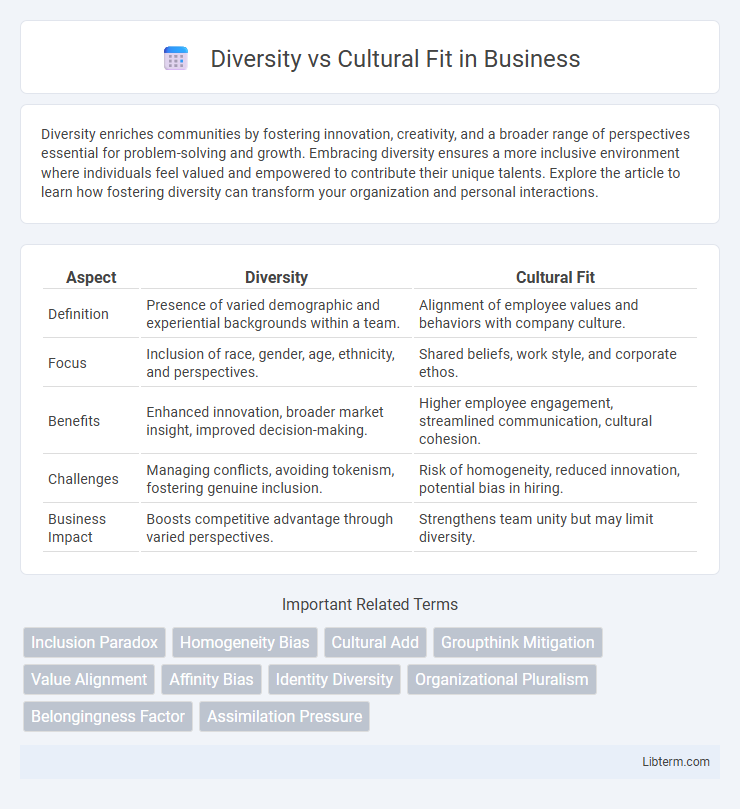Diversity enriches communities by fostering innovation, creativity, and a broader range of perspectives essential for problem-solving and growth. Embracing diversity ensures a more inclusive environment where individuals feel valued and empowered to contribute their unique talents. Explore the article to learn how fostering diversity can transform your organization and personal interactions.
Table of Comparison
| Aspect | Diversity | Cultural Fit |
|---|---|---|
| Definition | Presence of varied demographic and experiential backgrounds within a team. | Alignment of employee values and behaviors with company culture. |
| Focus | Inclusion of race, gender, age, ethnicity, and perspectives. | Shared beliefs, work style, and corporate ethos. |
| Benefits | Enhanced innovation, broader market insight, improved decision-making. | Higher employee engagement, streamlined communication, cultural cohesion. |
| Challenges | Managing conflicts, avoiding tokenism, fostering genuine inclusion. | Risk of homogeneity, reduced innovation, potential bias in hiring. |
| Business Impact | Boosts competitive advantage through varied perspectives. | Strengthens team unity but may limit diversity. |
Understanding Diversity in the Workplace
Understanding diversity in the workplace involves recognizing the value of varied backgrounds, experiences, and perspectives that employees bring to an organization. Embracing diversity enhances innovation, problem-solving, and decision-making by fostering an inclusive environment where different voices are heard and respected. Prioritizing diversity over strict cultural fit helps companies build dynamic teams that reflect a broad range of ideas and drive business success.
Defining Cultural Fit: What Does It Mean?
Cultural fit refers to the alignment between an employee's values, beliefs, and behaviors with the core values and norms of an organization, fostering a cohesive work environment. It emphasizes shared perspectives and workplace harmony, which can enhance team collaboration and employee satisfaction. However, defining cultural fit too narrowly may risk excluding diverse viewpoints, potentially limiting innovation and inclusivity.
The Benefits of Embracing Diversity
Embracing diversity enhances workplace innovation by integrating varied perspectives and experiences, leading to more creative problem-solving and decision-making. Companies with diverse teams show higher financial performance, as reported by McKinsey, linking inclusion to profitability and market growth. Promoting diversity fosters an inclusive culture that attracts top talent, improves employee engagement, and reduces turnover rates.
Potential Pitfalls of Overemphasizing Cultural Fit
Overemphasizing cultural fit in hiring processes can lead to homogeneity, limiting diversity and stifling innovation within organizations. This bias may result in exclusion of qualified candidates who bring different perspectives, undermining the benefits of diverse teams such as improved problem-solving and creativity. Companies risk reinforcing existing groupthink and missing opportunities for growth by prioritizing similarity over skill and potential.
Diversity vs. Cultural Fit: Striking the Right Balance
Striking the right balance between diversity and cultural fit requires organizations to embrace varied perspectives while maintaining core values that unify teams. Prioritizing diversity drives innovation, problem-solving, and market insight, yet cultural fit ensures alignment with organizational mission, promoting collaboration and employee satisfaction. Effective hiring strategies integrate inclusive recruiting practices with value-based assessments to create cohesive, dynamic work environments.
How Bias Impacts Hiring Decisions
Bias in hiring decisions often undermines diversity by favoring candidates who resemble existing employees, reinforcing cultural fit as a subjective and exclusionary criterion. Implicit biases lead recruiters to prioritize similarity over qualifications, reducing opportunities for underrepresented groups and limiting organizational innovation. Addressing these biases requires implementing structured interviews and objective evaluation metrics to ensure equitable and inclusive hiring practices.
Building Inclusive Teams: Strategies That Work
Building inclusive teams requires prioritizing diversity by actively seeking candidates from varied backgrounds and experiences, which enriches creativity and problem-solving. Emphasizing cultural fit often limits this by favoring homogeneity; instead, organizations should implement structured interviews and bias training to ensure merit-based evaluations. Leveraging employee resource groups and continuous feedback loops fosters an environment where diverse voices are valued and integrated into team dynamics.
Case Studies: Success Stories in Diversity and Inclusion
Case studies from global corporations like Microsoft and Salesforce demonstrate that prioritizing diversity over traditional cultural fit leads to increased innovation and employee satisfaction. Research shows diverse teams outperform homogeneous groups by 35% in decision-making and creativity, highlighting the measurable benefits of inclusive hiring practices. Companies embracing diverse perspectives report higher revenue growth, with McKinsey data indicating a 25% increase in profitability within the top quartile for ethnic and cultural diversity.
Rethinking Recruitment Practices for Modern Workplaces
Rethinking recruitment practices for modern workplaces involves prioritizing diversity over traditional cultural fit to foster innovation and inclusive environments. Employing structured interviews and unbiased assessment tools enhances candidate evaluation by focusing on skills and perspectives rather than conformity. Integrating diversity metrics into hiring strategies drives business performance and reflects evolving social expectations.
Future Trends in Diversity and Cultural Integration
Future trends in diversity emphasize the shift from traditional cultural fit models to dynamic cultural integration strategies that enhance innovation and employee engagement. Organizations are leveraging AI-driven analytics and inclusive leadership practices to identify and nurture diverse talent pools, fostering environments where multiple perspectives drive competitive advantage. Embracing intersectionality and continuous cultural adaptation will define the next generation of workforce diversity, promoting resilience in global markets.
Diversity Infographic

 libterm.com
libterm.com